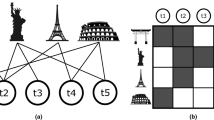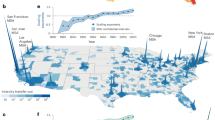Abstract
Larger agglomerations of individuals create a social environment can sustain a larger repertoire of intellectual capabilities, thereby facilitating the creation and recombination of ideas, and increasing the likelihood that interactions among individuals will occur through which new ideas are generated and shared. Relatedly, cities have long been the privileged setting for invention and innovation. These two phenomena are brought together in the superlinear scaling relationship whereby urban inventive output (measured through patenting) increases more than proportionally with increasing population size. We revisit the relationship between urban population size and patenting using data for a global set of metropolitan areas in the OECD and show, for the first time, that the superlinear scaling between patenting and population size observed for US metropolitan areas holds for urban areas across a variety of urban and economic systems. In fact the scaling relationships established for the US metropolitan system and for the global metropolitan system are remarkably similar.
Similar content being viewed by others
Notes
35 U.S.C., Chapter 10, §§ 101–103.
Roughly 53 percent of applications to the EPO were filed under the PCT (van Zeebroeck and van Pottelsberghe 2011).
For more on the differences got to http://www.bea.gov/regional/docs/econlist.cfm.
We thank an anonymous reviewer for bringing this issue to our attention and urging us to address it.
References
Acs, Z., Anselin, L., & Varga, A. (2002). Patents and innovation counts as measures of regional production of new knowledge. Research Policy, 31, 1069–1085.
Algaze, G. (2008). Ancient Mesopotamia at the dawn of civilization. Chicago: University of Chicago Press.
Arbesman, S., & Christakis, N. A. (2011). Scaling of prosocial behavior in cities. Physica A, 390, 2155–2159.
Arrow, K. (1962). The economic implications of learning by doing. Review of Economic Studies, 29, 155–173.
Bairoch, P. (1988). Cities and economic development: From the dawn of history to the present. Chicago: The University of Chicago Press.
Barenblatt, G. I. (2003). Scaling. Cambridge: Cambridge University Press.
Bettencourt, L. M. A. (2012). The origin of scaling in cities. Santa Fe Institute working paper 12-09-014. Santa Fe: Santa Fe Institute.
Bettencourt, L. M. A., Lobo, J., Helbing, D., Kühnert, C., & West, G. (2007a). Growth, innovation, scaling and the pace of life in cities. Proceedings of the National Academy of Sciences, 104, 7301–7306.
Bettencourt, L. M. A., Lobo, J., & Strumsky, D. (2007b). Invention in the city: Increasing returns to patenting as a scaling function of metropolitan size. Research Policy, 36, 107–120.
Bettencourt, L. M. A., Lobo, J., Strumsky, D., & West, G. (2010). Urban scaling and its deviations: Revealing the structure of wealth, innovation and crime across cities. PLoS ONE, 5, e13541. doi:10.1371/journal.pone.0013541.
Boserup, E. (1981). Population and technological change: A study of long-term trends. Chicago: University of Chicago Press.
Boyd, R., Richerson, P. J., & Henrich, J. (2011). The cultural niche: Why social learning is essential for human adaptation. Proceedings of the National Academy of Sciences, 108, 10918–10925.
Brock, W. A. (1999). Scaling in economics: A readers’ guide. Industrial and Corporate Change, 8, 409–446.
Carlino, G. A. (1979). Increasing returns to scale in metropolitan manufacturing. Journal of Regional Science, 19, 343–351.
Carneiro, R. (2000). The transition from quantity to quality: A neglected causal mechanism in accounting for social evolution. Proceedings of the National Academy of Sciences, 97, 12926–12931.
Carneriro, R. (1962). Scale analysis as an instrument for the study of cultural evolution. Southwestern Journal of Anthropology, 18, 149–169.
Chave, E., & Levin, S. A. (2003). Scale and scaling in ecological and economic systems. Environmental and Resource Economics, 26, 527–557.
Criscuolo, P. (2006). The ‘home advantage’ effect and patent families. A comparison of OECD triadic patents, the USTPTO and EPO. Scientometrics, 66, 23–41.
Diamond, J. (1978). The longest isolation, the simplest technology. Nature, 273, 185–186.
Diamond, J. (1997). Guns, germs, and steel. New York: W.W. Norton and Company.
Dumond, D. E. (1965). Population growth and cultural change. Southwestern Journal of Anthropology, 21, 302–324.
Duranton, G., & Jayet, H. (2011). Is the division of labour limited by the extent of the market?Evidence from French cities. Journal of Urban Economics, 69, 56–71.
Duranton, G., Martin, P., Mayer, T., & Mayneris, F. (2010). The Economics of clusters: Evidence from France. Oxford: Oxford University Press.
Ember, M. (1963). The relationship between economic and political development in nonindustrial societies. Ethnology, 2, 228–248.
Forman, C., Goldfarb, A., & Greenstein, S. (2008). Understanding the inputs into innovation: Do cities substitute for internal firm resources? Journal of Economics and Management Strategy, 17, 295–316.
Gabaix, X. (2009). Power laws in economics and finance. Annual Review of Economics, 1, 255–293.
Glaeser, E. L. (2011). Triumph of the city. New York: Penguin.
Griliches, Z. (1990). Patent statistics as economic indicators: A survey. Journal of Economic Literature, 28, 1661–1707.
Hall, P. (1998). Cities in civilization. New York: Pantheon.
Hasan, I., & Tucci, C. L. (2010). The innovation-economic growth nexus: Global evidence. Research Policy, 39, 1264–1276.
Hunt, R. M., Carlino, G., & Chatterjee, S. (2007). Urban density and the rate of invention. Journal of Urban Economics, 61, 389–419.
Jacobs, J. (1984). Cities and the wealth of nations. New York: Random House.
Jaffe, A. B., & Trajtenberg, M. (2002). Patents, citations, and innovations: q window on the knowledge economy. Cambridge: MIT.
Jaffe, A. B., Trajtenberg, M., & Henderson, R. (1993). Geographic localization of knowledge spillovers as evidenced by patent citations. Quarterly Journal of Economics, 108, 577–598.
Jones, C. I., & Romer, P. M. (2010). The new Kaldor facts: Institutions, population, and human capital. American Economic Journal: Macroeconomics, 2, 224–245.
Katz, J. S. (2006). Indicators for complex innovation systems. Research Policy, 35, 893–909.
Klasen, S., & Nestmann, T. (2006). Population, population density and technological change. Journal of Population Economics, 19, 611–626.
Kline, M. A., & Boyd, R. (2010). Population size predicts technological complexity in Oceania. Proceedings of the Royal Society B, 277, 2559–2564.
Knudsen, B., Florida, R., Stolarick, K., & Gates, G. (2008). Density and creativity in US regions. Annals of the Association of American Geographers, 98, 461–478.
Kremer, M. (1993). Population growth and technological change: One million B.C. to 1990. Quarterly Journal of Economics, 108, 681–716.
Lee, R. D. (1987). Population dynamics of humans and other animals. Demography, 24, 443–466.
Lee, R. D. (1988). Induced population growth and induced technological progress: Their interaction in the accelerating stage. Mathematical Population Studies, 1, 265–288.
Lobo, J., & Strumsky, D. (2008). Metropolitan patenting, inventor agglomeration and social networks: A tale of two effects. Journal of Urban Economics, 63, 871–884.
Maraut, S., Dernis, H., Webb, C., Spiezia, V. & Guellec, D. (2008). The OECD REGPAT database: a presentation. OECD Statistical Analysis of Science, Technology and Industry Working Paper
Marx, M., Strumsky, D., & Fleming, L. (2009). Noncompetes and inventor mobility: Specialists, stars, and the Michigan experiment. Management Science, 55, 875–889.
Mokyr, J. (1990). The level of riches: Technological creativity and economic progress. New York: Oxford University Press.
Moomaw, R. L. (1981). Productivity and city size? A critique of the evidence. Quarterly Journal of Economics, 96, 675–688.
Mumford, L. (1968). The city in history: its origins, its transformations, and its prospects. New York: Mariner Books.
Narin, F. (1994). Patent Bibliometrics. Scientometrics, 30, 147–155.
Naroll, R. (1956). A preliminary index of social development. American Anthropologist, 58, 687–715.
OECD (2012). Patents by regions. Organization for Economic Cooperation and Development Patent Statistics (database). doi: 10.1787/data-00509-en
Price, D. J. S. (1969). Measuring the size of science. Proceedings of the Israel Academy of Sciences and Humanities, 4, 1–14.
Puga, D. (2010). The magnitude and causes of agglomeration economies. Journal of Regional Science, 50, 203–219.
Rauch, J. E. (1993). Productivity gains from geographic concentration of human capital: Evidence from cities. Journal of urban Economics, 34, 380–400.
Redman, C. (1979). The rise of civilization: from early farmers to urban society in the ancient Near East. San Francisco: W.H. Freeman & Co. Ltd.
Romer, P. M. (2010). What parts of globalization matter for catch-up growth? American Economic Review, 100, 94–98.
Sedgley, N., & Elmslie, B. (2011). Do we still need cities? evidence on rates of innovation from count data models of metropolitan statistical area patents. American Journal of Economic Sociology, 70, 86–108.
Segal, D. (1976). Are there returns to scale in city size? The Review of Economics and Statistics, 58, 339–350.
Shefer, D. (1973). Localization economies in SMSAs: A production function approach. Journal of Regional Science, 13, 55–64.
Shennan, S. J. (2002). Genes, memes and human history: Darwinian archaeology and cultural evolution. London: Thames and Hudson.
Simon, J. (1977). The economics of population growth. Princeton: Princeton University Press.
Simon, J. (1986). Theory of population and economic growth. Oxford: Basil Blackwell.
Spufford, P. (2003). Power and profit: the merchant in medieval Europe. London: Thames & Hudson.
Sveikauskas, L. (1975). The productivity of cities. Quarterly Journal of Economics, 89, 393–413.
Uslaner, E. (1976). The pitfalls of per capita. American Journal of Political Science, 20, 125–133.
van Zeebroeck, N., & van Pottelsberghe de la Potterie, B. (2011). Filing strategies and patent value. Economics of Innovation and New Technology, 20, 539–561.
Wirth, L. (1938). Urbanism as a way of life. The American Journal of Sociology, 44, 1–24.
Author information
Authors and Affiliations
Corresponding author
Rights and permissions
About this article
Cite this article
Lobo, J., Strumsky, D. & Rothwell, J. Scaling of patenting with urban population size: evidence from global metropolitan areas. Scientometrics 96, 819–828 (2013). https://doi.org/10.1007/s11192-013-0970-3
Received:
Published:
Issue Date:
DOI: https://doi.org/10.1007/s11192-013-0970-3




